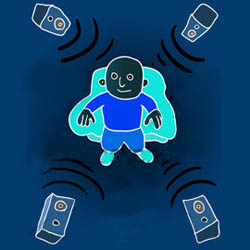
Good Front Sound
Many think of “5.1” when they think surround. But five-channel sound was developed for cinema applications and recording media with a limited number of channels.
Fortunately, it incorporates the left-center-right front loudspeaker arrangement that is usually the best way to provide good front sound staging.
But for live surround sound, one only needs to address the geometry of the venue without concern about conventional layout standards, recording formats, or recording media limitations.
Additional mixer outputs can be set up to drive individual loudspeaker feeds as needed.
Signal routing can be established to meet the directionality needs of the program material, which may call for six, eight, or more surround channels.
Although panning a sound between adjacent channels is a convenient method of routing, and is offered by virtually all mixing consoles, it is not necessarily the best method for every source.
With acoustic music, especially with a group of performers, one can use multiple microphones and route them to individual loudspeakers or output channels.
This method produces low correlation and natural delay between the channels, resulting in improved spaciousness, more transparency, and better clarity.
There is debate among some regarding the necessity of maintaining stereo separation into the low bass frequency range. In the case of surround sound, this multiplies the amount of equipment while reducing its utilization.
As with home theater, good results are possible using just one or two front subwoofer channels if they are crossed over at a low enough frequency. This should be a viable option when budget or physical constraints dictate, and even if they don’t, good coverage of the audience may be a higher priority than directional bass.
The rewards of surround sound music can be great. As with cinema, a surround sound concert system allows a more dramatic and entertaining show. The additional output channels, loudspeakers, and spatial sound distribution yield more dynamic impact without excessive loudness.
In addition, as more artists incorporate surround sound into their performances, the demand for this type of sound system may increase. The technology seems to be largely driven by the production of surround DVDs, and the gradual realization that surround channels are not just for reverb and applause.
The increasing popularity of surround sound music for home playback might lead to increased demand for surround sound at live concerts.
Although this may seem backward, it’s a practical reality that excellent surround sound can be recorded for playback at home, while the use of surround at a live concert is a relatively complex and expensive proposition. But just as stereo sound has mostly replaced mono, it’s logical that in the future surround capability may see increasing use in live concerts.
Michael Miles has two decades of product and system design experience, and he holds an Electrical Engineering degree from the University of Michigan.
